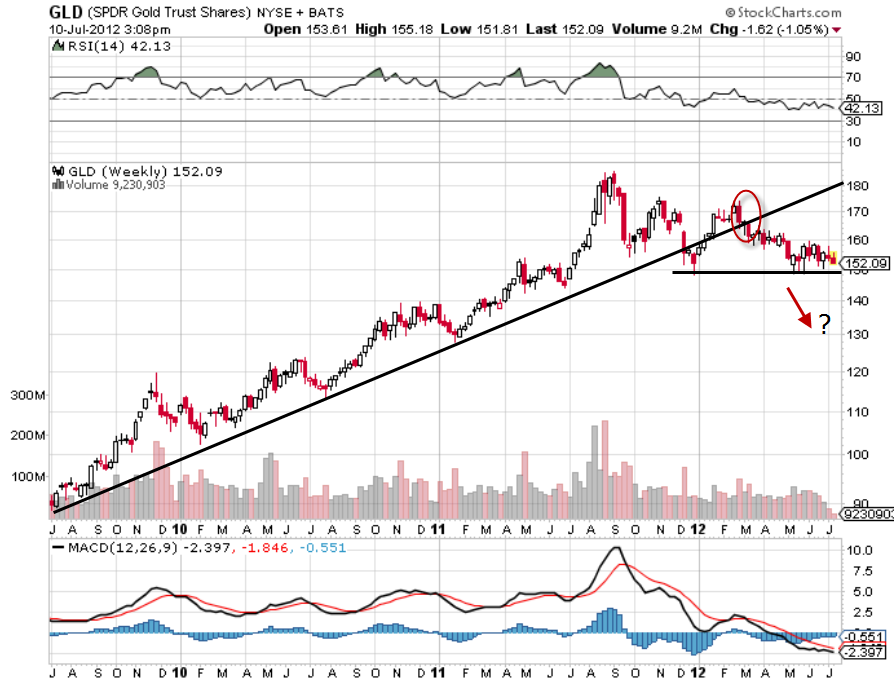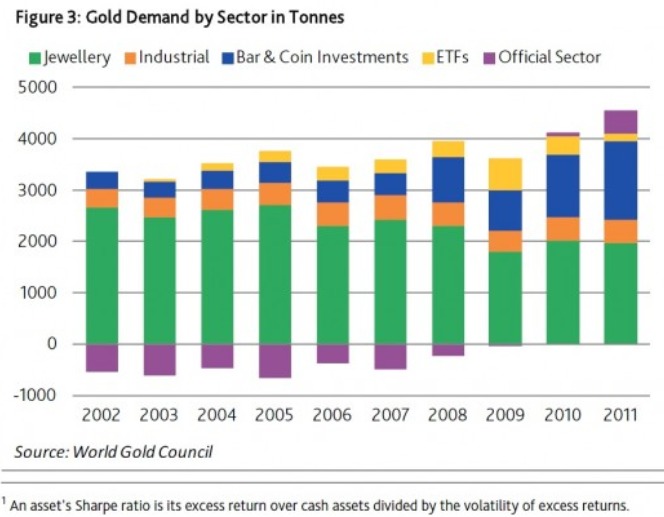by Michael Tarsala
 Don’t fight the Fed – especially when it comes to gold investing, says Christopher Henwood, editor of The Henwood Edge and a former trading VP at Goldman affiliate J. Aron.
Don’t fight the Fed – especially when it comes to gold investing, says Christopher Henwood, editor of The Henwood Edge and a former trading VP at Goldman affiliate J. Aron.
“It would be very short-sighted to think that you can out-guess the people who will have the greatest impact on the market, and that’s the Fed and other central bankers,” Henwood said in an exclusive interview with Covestor.
“If Fed signals anything at all that will positive for gold, you want to be on board. I think it’s a poor risk-reward to do anything else. And I think that there is more upside for gold than there is downside.”
Gold has not looked shiny at all in recent months. Below you see the chart of the SPRD Gold Trust Shares (GLD), which mirrors gold price movements. It broke down from its multi-year uptrend in March. And critical volume support around the $150 mark is now close to being tested.
Can it possibly hold that key support level?

Source: Stockcharts.com
It’s a “triangle” chart pattern that market technicians typically expect to end in a breakdown.
The one reason to think it might hold, though, is that central governments are now adding more gold to their balance sheets than at any point in the past 10 years, according to data from the World Gold Council, and cited in this chart by FT Alphaville:

Source: World Gold Council via FT Alphaville
The “official sector’ is the activity of central banks. After seven straight years of declining gold stakes, followed by two years of little to no increases, governments are again adding gold to their coffers.
Central banks may have four main reasons to add gold:
- Partly as a hedge in times of trouble
- To allow countries outside the U.S. to intervene in their currency markets
- To help some sovereigns maintain their credit ratings
- Because they think gold is a value, and will head higher from here
Henwood thinks it’s a bad idea – in general – to fight central governments.
It’s an even worse idea when they hold the trigger on stimulus actions, he says. Government stimulus helped to provide fuel for gold rallies in the past few years – most notably during QE1 and 2. Gold became more attractive than government currencies that were seen as inflated.
Keep in mind, three Fed governors came out in support of more quantitative easing this week – the Chicago, Boston and San Francisco Fed chiefs, respectively.
Economists now think that QE3 will happen as well: Those working for the primary dealers that do business with the Fed believe there is a 70% chance of another large-scale quantitative easing round, according to a Reuters poll following the Friday jobs report.
Risk management expert and former Fed examiner Mark T. Williams argues that gold prices will remain under pressure because it is an asset bubble. He notes that production margins for the miners are about double their long-term average. The market is just starting to recognize that, he says. This year marks the first time that gold has underperformed the Dow Jones Industrials in a decade.
Henwood counters that gold is now seen differently by the markets than it was in the past:
Gold is playing different roles. For a long time, it was seen mainly as a hedge against inflation. Now it’s being used as a hedge against inflation, as well as deflation, a geopolitical hedge, and even a hedge against declines in other commodities.
Perhaps more importantly, there are many more players in gold market than there ever were before. Historically, it was a market where banks and very large trading houses played.
Now it’s a market that in recent years has been opened up to the masses, thanks to gold ETFs. Meanwhile, people are buying more physical gold than ever before. Then you have both China and India enjoying higher standards of living, and both of their societies are traditional buyers of gold.
So for me, to focus on historical ratios alone ignores who is buying gold and why.
It’s central banks that are buying. It’s for several reasons, including as a defensive move.
And it might not be a good idea for the little guy to fight them.



